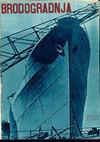Analysis of the double steps position effect on planing hull performances
IF 4.2
4区 工程技术
Q1 ENGINEERING, MARINE
引用次数: 2
Abstract
Along with developing high-speed craft technology, the planing hull is growing with modifications for better performance. One such technology is stepped hull, both single and double. Planing hull with steps allows the boat to run at a relatively low drag-lift ratio with lower frictional resistance due to reduced wetted area. In this study, the hull was modified with variations in the position of the double steps, which aimed to determine the effect of the first and second step positions on the total resistance, dynamic trim, and dynamic sinkage generated by computational fluid dynamics (CFD). Based on the analysis results, variations in the position of the stepped can change the hull performance. Shortening the distance between the two steps and moving both rearwards toward the transom can lower the total resistance. The dynamic trim and dynamic sinkage decreased as the position of the two steps was shifted further forward. An equation created in a non-dimensional form relates the positions of two steps to the desired results of total resistance, dynamic trim, and dynamic sinkage, namely: {(x1-x2)/L + (x1x2)/(LB)} × Fr∇, where x1 is distance the first step from transom, x2 is the distance of the second step, L is the length of the boat, B is the beam of the boat, and Fr∇ is the volume Froude number.双台阶位置对滑行船体性能的影响分析
随着高速航行技术的发展,滑行船体也在不断改进,以获得更好的性能。一种这样的技术是阶梯式船体,包括单体和双体。带有台阶的扁平船体使船能够以相对较低的阻力-升力比运行,并且由于润湿面积的减少而具有较低的摩擦阻力。在这项研究中,随着双台阶位置的变化对船体进行了修改,旨在确定第一和第二台阶位置对计算流体动力学(CFD)产生的总阻力、动态配平和动态下沉的影响。根据分析结果,阶梯位置的变化会改变船体性能。缩短两个台阶之间的距离并将两个台阶向后移向横梁可以降低总阻力。随着两个台阶的位置进一步向前移动,动态配平和动态下沉量减小。一个以无量纲形式创建的方程将两个台阶的位置与总阻力、动态纵倾和动态下沉的期望结果联系起来,即:{(x1-x2)/L+(x1x2)/(LB)}×Frõ,其中x1是第一个台阶到横框的距离,x2是第二个台阶的距离,L是船的长度,B是船的梁,并且Frř是体积弗劳德数。
本文章由计算机程序翻译,如有差异,请以英文原文为准。
求助全文
约1分钟内获得全文
求助全文
来源期刊

Brodogradnja
ENGINEERING, MARINE-
CiteScore
4.30
自引率
38.90%
发文量
33
审稿时长
>12 weeks
期刊介绍:
The journal is devoted to multidisciplinary researches in the fields of theoretical and experimental naval architecture and oceanology as well as to challenging problems in shipbuilding as well shipping, offshore and related shipbuilding industries worldwide. The aim of the journal is to integrate technical interests in shipbuilding, ocean engineering, sea and ocean shipping, inland navigation and intermodal transportation as well as environmental issues, overall safety, objects for wind, marine and hydrokinetic renewable energy production and sustainable transportation development at seas, oceans and inland waterways in relations to shipbuilding and naval architecture. The journal focuses on hydrodynamics, structures, reliability, materials, construction, design, optimization, production engineering, building and organization of building, project management, repair and maintenance planning, information systems in shipyards, quality assurance as well as outfitting, powering, autonomous marine vehicles, power plants and equipment onboard. Brodogradnja publishes original scientific papers, review papers, preliminary communications and important professional papers relevant in engineering and technology.
 求助内容:
求助内容: 应助结果提醒方式:
应助结果提醒方式:


